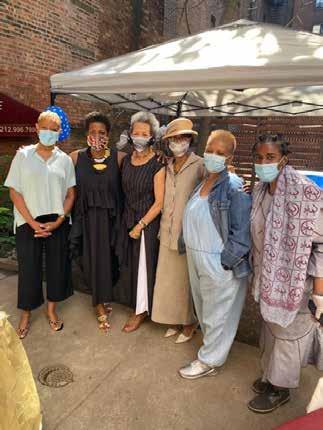
6 minute read
Health
HEALTH Why Weighing Your Medicare Part D Options is Crucial This Year
(Statepoint)
Advertisement
You likely hear the same word of ad vice every fall: review your Medicare Part D plan. While you may be tempted to stick with what you have, it’s important to remember that plan specifics change annually, your health needs are always evolving, and as this year has shown, unexpected global events can impact your health and finances. For all these rea sons, doing your homework is not only important, it has the power to substantially reduce your out-of-pocket costs.
To help those turning 65 and older make sense of their options, Turner offers the following tips: • Don’t procrastinate: Part D enrollment is taking place from Oct. 15 through Dec. 7 this year. If you’re like most people, you may be inclined to delay your decision. Indeed, nine out of 10 people wait until the last minute to select a plan, ac cording to Express Scripts. However, the selection pro cess can be complicated, so don’t deprive yourself of the time needed to thoughtfully comparison shop.
Factor in how the COVID-19 landscape has potentially impacted your selection process. With
PHOTO SOURCE: (c) bernardbodo / iStock via Getty Images Plus
many in-person resources (e.g., local Medicare work shops, working with a broker or agent, etc.) being conducted virtually or requiring advance scheduling this year, you can get ahead of the game by starting early.
One good resource to check out is RoadmapFor Medicare.com, a free access website now offering short educational videos, record ed webinars and articles with tips to select the plan that’s best for you. The site also features FAQs and ex pert advice so you can better assess your options. • Look beyond premi ums: While reviewing your options, look at the multi ple factors which can affect your overall costs over the course of the year. While a lower premium might save you money upfront, these plans can have much high er copayments, which over time can add up. • Check coverage: Plans change annually, so don’t assume that because your medications were covered under a certain plan last year that they will be covered again this year. Before en rolling or re-enrolling, check that your current drugs will be covered. Likewise, check out each plan’s pharmacy network and what is covered to ensure that it meets your needs. For example, you may find that right now, your top priority is the safety and convenience of home deliv ery of prescriptions drugs in order to reduce your chances of exposure to coronavirus. • Get savvy: Free expert advice can help you navi gate the selection process and make informed deci sions about your healthcare. Be sure to look for trusted sources who can provide the information you need to pick the plan that will work best for you and your bud get.
Take a closer look at your Medicare Part D choices. In these uncertain times, it is particularly important to be prepared to weather whatev er comes your way.
Peoplewith Medicare, MarkYourCalendars!
We Buy Records Top $$$
Open enrollment is October 15th to December 7th, 2020. During this period, you can sign up for or switch your Medicare Prescription Drug Plan and/or Medicare Advantage Plan. All changes are effective January 1, 2021 . For more information, call Aging Connect at 212-244-6469 and ask for “HIICAP” or “SHIP”


Jazz, Soul, Latin, Rock, Salsa 33’s, 45’s, 78’s Call Al 201-281-5604
HEALTH Polycystic Kidney Disease: Is It Hiding in Your Genes?
(Statepoint)
Polycystic Kidney Disease (PKD), causes numerous cysts to grow in the kidneys and for those affected by this condition, nearly 50% will experience End Stage Renal Disease (ESRD) by age 60. According to the National Kidney Foundation, autosomal dominant polycystic kidney disease (ADPKD) accounts for as many as 90% of all polycystic kidney disease cases.
Dr. Charlotte Jones-Burton of Otsuka Pharmaceutical Development & Commercialization, Inc. offers the following insights into the condition:
The most common inherited kidney disorder
ADPKD, the most common form of PKD, is a genetic kidney disease that leads to cyst formation and kidney growth. Additionally, ADPKD is the most common inherited renal disease/kidney disorder and according to recent data, affects as many as 140,000 Americans. Overall, ADPKD is the fourth leading cause of ESRD. ADPKD is a progressive condition and may eventually lead to kidney failure requiring some form of renal replacement therapy, either dialysis or kidney transplant.
While ADPKD is considered a rare disease and is relatively unknown to most people, it’s unfortunately all too common in families impacted by the condition. Children of parents with ADPKD have a 50% chance of inheriting the disease. This is a sobering statistic, however, a critical first step for people with a family history of chronic kidney disease or ADPKD is to discuss the condition with relatives and a kidney care specialist as early as possible. However, not all cases of ADPKD are
PHOTO SOURCE: (c) monkeybusinessimages / iStock via Getty Images Plus

inherited, in approximately 5%‒10% of patients with ADPKD, no family history can be documented, suggesting spontaneous mutations.
How ADPKD is diagnosed
Typically, ADPKD is diagnosed by ultrasound, however, a computerized tomography (CT) scan or magnetic resonance imaging (MRI) may also be conducted. Genetic testing may also be used for people with inconclusive imaging results, those with no family history of the condition, those who want to determine if they can pass the gene on to their children, and for diagnosis of possible kidney donors.
Using the latest technologies, physicians can now identify ADPKD patients at risk for rapid progression of kidney function decline as well as estimate how quickly someone with ADPKD is likely to progress based on the size of his or her kidneys. Although disease progression can be highly variable, even among family members, it’s important to confirm diagnosis early on, as patients with rapidly progressing ADPKD reach ESRD at a younger age.
Management strategies
Since ADPKD worsens with time, early diagnosis and treatment is critical. While signs and symptoms of ADPKD often develop between the ages of 30 and 40, individuals with a history of kidney diseases – especially if they know ADPKD is in their family – shouldn’t delay speaking with a kidney specialist, also known as a nephrologist. By acting early, they’ll be able to take steps to help protect kidney function and properly manage the disease, as well as help avoid related complications such as high blood pressure, urinary tract infections, kidney stones, infected or bleeding cysts, abdominal bloating/discomfort and chronic pain.
Educational resources, such as www.PKDInfo.com, can help people have an informed conversation with a doctor about ADPKD. The website provides the latest information for understanding the disease and learning more about developing an effective management strategy, such as maintaining a healthy diet, staying physically active, getting enough sleep and aiming for a healthy weight to help keep kidneys healthy.
Concerned about ADPKD? Use trusted resources to get the facts or schedule an appointment with your doctor to learn more about your risk factors and management strategies.
WE MAY BE APART, BUT WE’RE NOT ALONE

SOMEONE WHO CARES IS JUST A PHONE CALL AWAY.
If you or someone you love is feeling isolated or anxious in these challenging times, hearing a friendly voice on the phone may help. That’s why we created the AARP Friendly Voice program – a trained, caring group of volunteers standing by ready to chat, listen, or just say hello.









